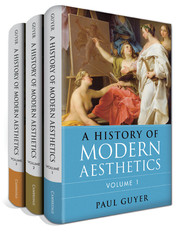Book contents
- Volume 1 The Eighteenth Century
- Volume 2 The Nineteenth Century
- Volume 3 The Twentieth Century
- Frontmatter
- Contents
- Acknowledgments
- Introduction
- Part One German Aesthetics in the Twentieth Century
- Part Two Aesthetics in Britain until World War II
- Part Three American Aesthetics in the First Half of the Twentieth Century
- Part Four Wittgenstein and After
- 11 Wittgenstein
- 12 The First Wave
- 13 The Second Wave
- Epilogue Truth, Feeling, and Play in Recent Aesthetics
- Bibliography
- References
12 - The First Wave
from Part Four - Wittgenstein and After
Published online by Cambridge University Press: 05 June 2015
- Volume 1 The Eighteenth Century
- Volume 2 The Nineteenth Century
- Volume 3 The Twentieth Century
- Frontmatter
- Contents
- Acknowledgments
- Introduction
- Part One German Aesthetics in the Twentieth Century
- Part Two Aesthetics in Britain until World War II
- Part Three American Aesthetics in the First Half of the Twentieth Century
- Part Four Wittgenstein and After
- 11 Wittgenstein
- 12 The First Wave
- 13 The Second Wave
- Epilogue Truth, Feeling, and Play in Recent Aesthetics
- Bibliography
- References
Summary
Wittgenstein’s Investigations and then the Lectures had an immediate impact in the United States, Britain, and Commonwealth countries under British intellectual influence such as New Zealand; in the British sphere, the way for the influence of Wittgenstein’s published works had already been prepared by his personal teaching and by the emergence of the “ordinary language” movement at Oxford, led by such figures as Gilbert Ryle and J.L. Austin, while in the United States it had also been prepared by Americans who had studied with Wittgenstein in Cambridge, such as Norman Malcolm (1911–94) at Cornell. Here Wittgenstein’s influence will be presented as occurring in three stages. In the first stage, Wittgenstein’s replacement of definitions with “family resemblances,” his rejection of broad terms of aesthetic evaluation such as “beautiful” in favor of more particular predicates or judgments of rightness not using special aesthetic terms at all, and his apparent insistence that there can be no public discourse about private experiences led to a broad attack upon traditional aesthetic theories. Wittgenstein’s own critiques of traditional aesthetic theorizing also coincided with the increasing impact of avant-garde twentieth-century art on professional philosophers. This first stage of Wittgensteinianism in aesthetics can be regarded as having culminated in the approaches to the definition of art taken by Arthur Danto in his seminal paper “The Artworld” of 1964 and his 1981 book The Transfiguration of the Commonplace and by George Dickie in his articles from the 1960s and his 1974 book Art and the Aesthetic.
- Type
- Chapter
- Information
- A History of Modern Aesthetics , pp. 449 - 498Publisher: Cambridge University PressPrint publication year: 2014



